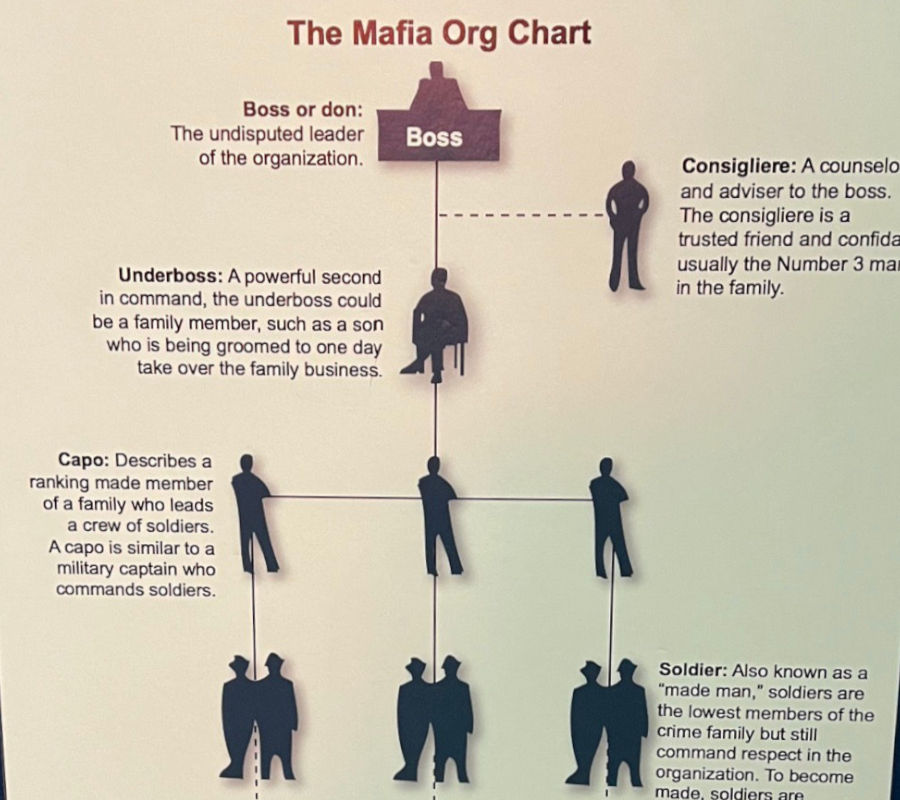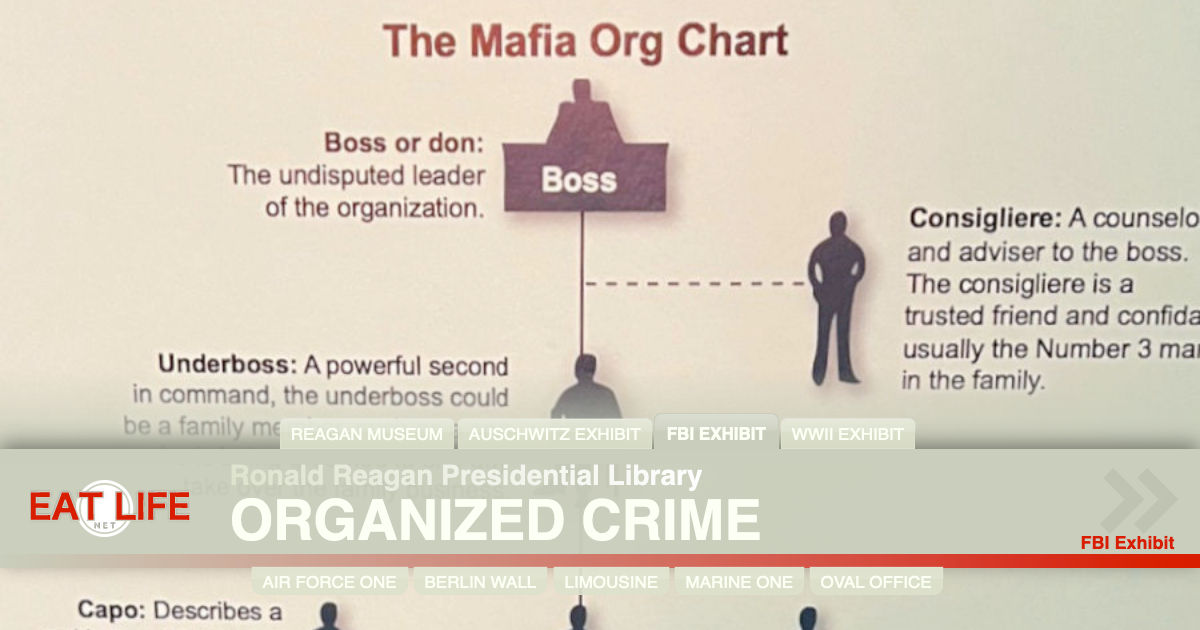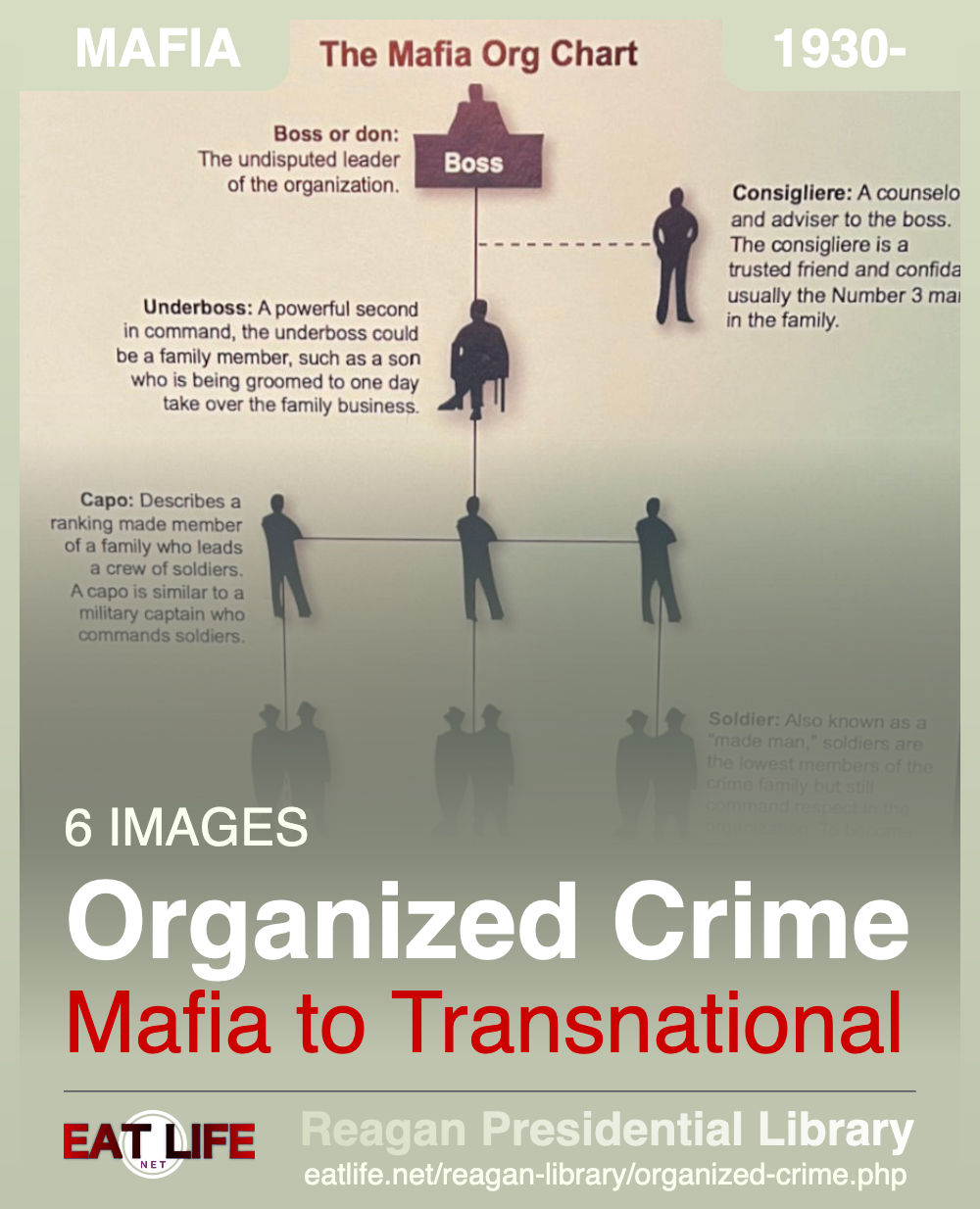MAFIA:
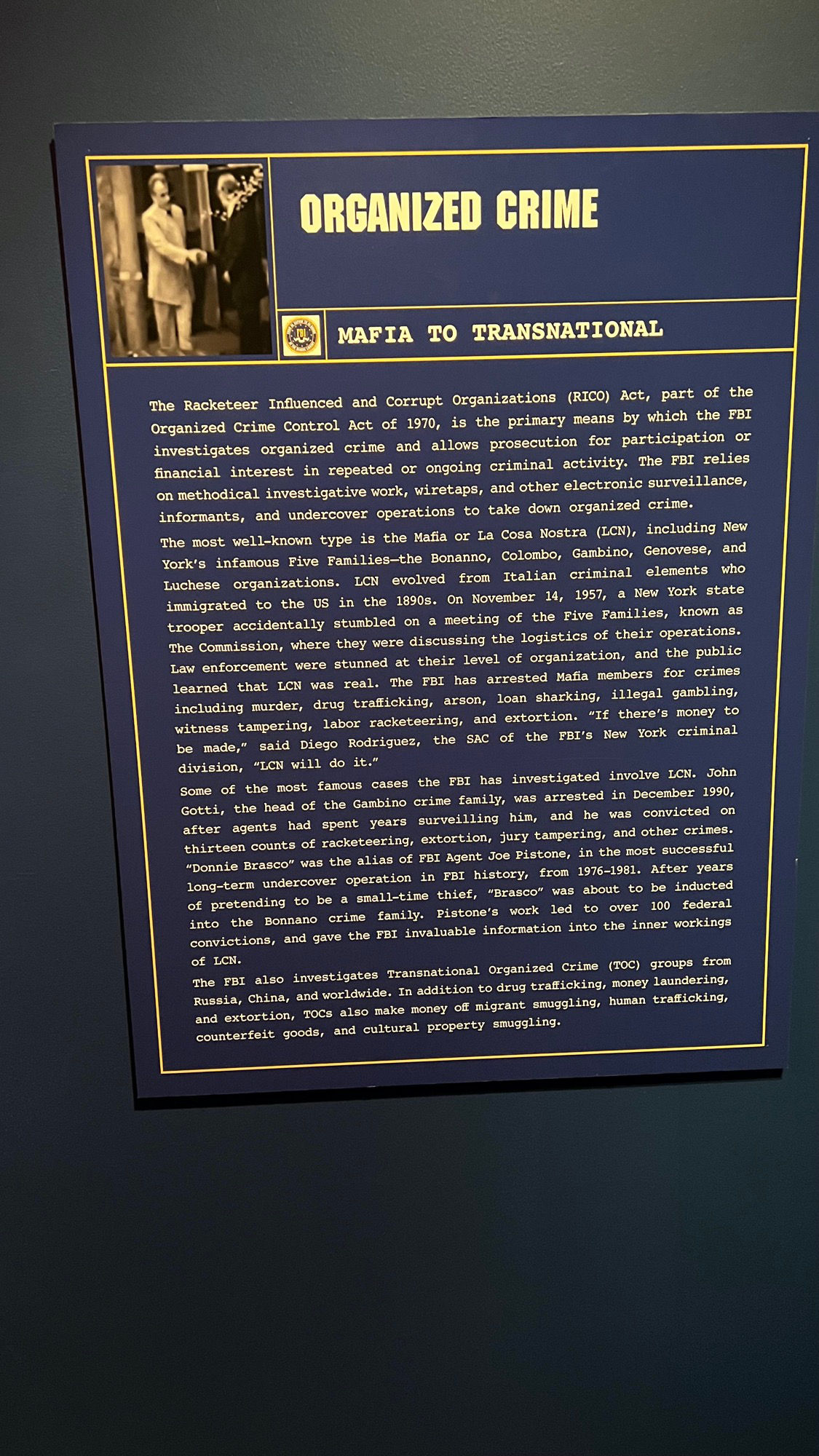
Mafia to Transnational
The Racketeer Influenced and Corrupt Organizations (RICO) Act, part of the Organized Crime Control Act of 1970, is the primary means by which the FBI investigates organized crime and allows prosecution for participation or financial interest in repeated or ongoing criminal activity. The FBI relies on methodical investigative work, wiretaps, and other electronic surveillance, informants, and undercover operations to take down organized crime.
The most well-known type is the Mafia or La Cosa Nostra (LCN), including New York's infamous Five Families - the Bonanno, Colombo, Gambino, Genovese, and Luchese organizations. LCN evolved from Italian criminal elements who immigrated to the US in the 1890s. On November 14, 1951, a New York state trooper accidentally stumbled on a meeting of the Five Families, known as The Commission, where they were discussing the logistics of their operations. Law enforcement were stunned at their level of organization, and the public learned that LCN was real. The FBI has arrested Mafia members for crimes including murder, drug traficking, arson, loan sharking, illegal gambling, witness tampering, labor racketeering, and extortion. "If there's money to be made," said Diego Rodriguez, the SAC of the FBI's New York criminal division, "LCN will do it."
Some of the most famous cases the FBI has investigated involve LCN. John Gotti, the head of the Gambino crime family, was arrested in December 1990, after agents had spent years surveilling him, and he was convicted on thirteen counts of racketeering, extortion, jury tampering, and other crimes. "Donnie Brasco" was the alias of FBI Agent Joe Pistone, in the most successful long-term undercover operation in FBI history, from 1976-1981. After years of pretending to be a small-time thief, "Brasco" was about to be inducted into the Bonnano crime family. Pistone's work led to over 100 federal convictions, and gave the FBI invaluable information into the inner workings of LCN.
The FBI also investigates Transnational Organized Crime (TOC) groups from Russia, China, and worldwide. In addition to drug trafficking, money laundering, and extortion, TOCs also make money off migrant smuggling, human trafficking, counterfeit goods, and cultural property smuggling.
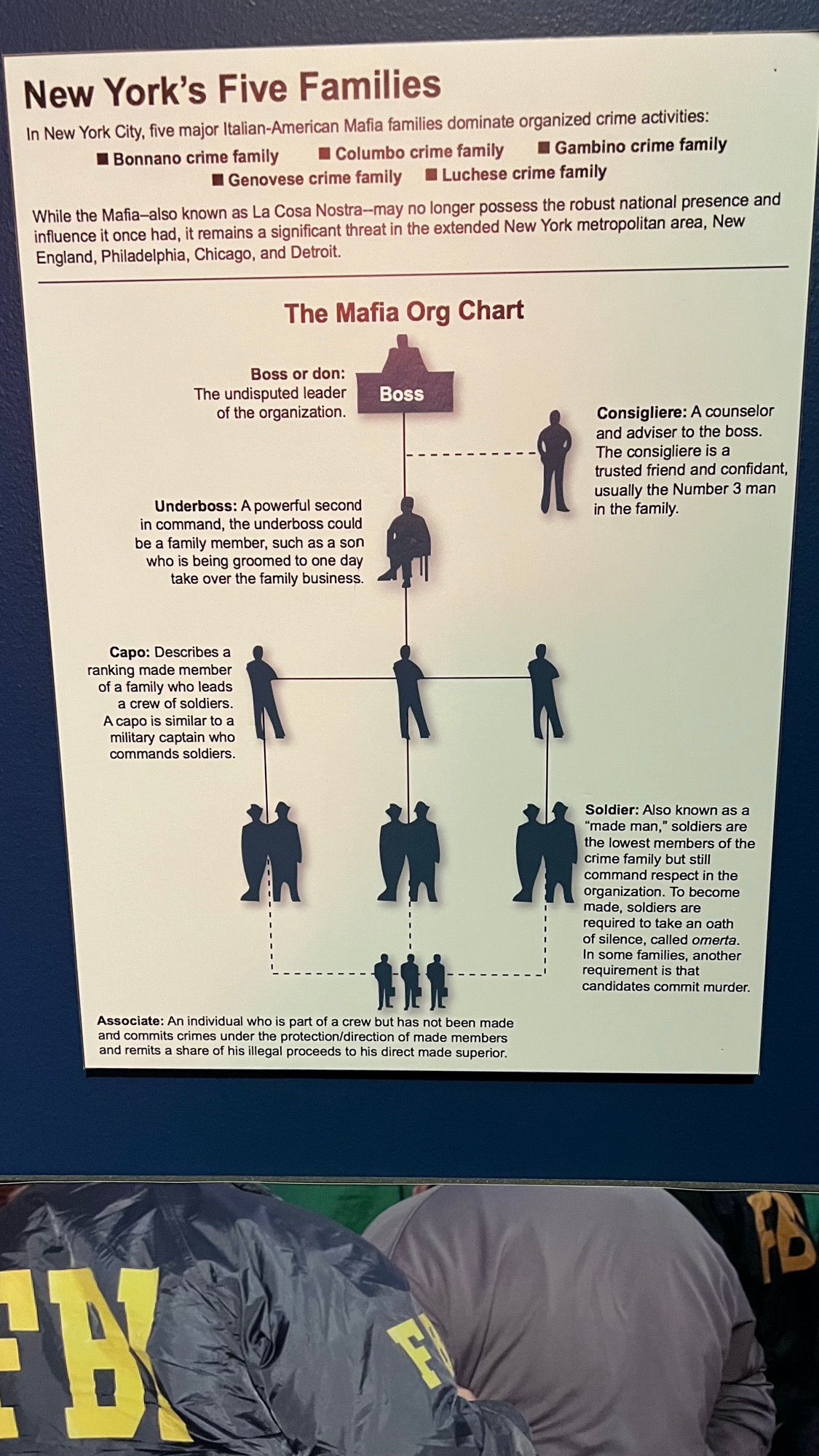
In New York City, five major Italian-American Mafia families dominate organized crime activities:
- Bonnano crime family
- Columbo crime family
- Gambino crime family
- Genovese crime family
- Luchese crime family
While the Mafia - also known as La Cosa Nostra - may no longer possess the robust national presence and influence it once had, it remains a significant threat in the extended New York metropolitan area, New England, Philadelphia, Chicago, and Detroit.
The Mafia Org Chart
- Boss or Don
The undisputed leader of the organization. - Consiglier:
A counselor and adviser to the boss. The consigliere is a trusted friend and confidant, usually the Number 3 man in the family. - Underboss
A powerful second in command, the underboss could be a family member, such as a son who is being groomed to one day take over the family business. - Capo
Describes a ranking made member of a family who leads a crew of soldiers. A capo is similar to a military captain who commands soldiers. - Soldier
Also known as a "made man," soldiers are the lowest members of the crime family but still command respect in the organization. To become made, soldiers are required to take an oath of silence, called omerta. In some families, another requirement is that candidates commit murder. - Associate
An individual who is part of a crew but has not been made and commits crimes under the protection/direction of made members and remits a share of his illegal proceeds to his direct made superior.
WIKIPEDIA The Five Families
The Five Families refer to five Italian American Mafia crime families that operate in New York City. In 1931, the five families were organized by Salvatore Maranzano following his victory in the Castellammarese War.Maranzano reorganized the Italian American gangs in New York City into the Maranzano, Profaci, Mangano, Luciano, and Gagliano families, which are now known as the Bonanno, Colombo, Gambino, Genovese, and Lucchese families. Each family had a demarcated territory and an organizationally structured hierarchy and reported to the same overarching governing entity. Initially, Maranzano intended each family's boss to report to him as the capo dei capi ("boss of all the bosses").
However, this led to his assassination that September, and that role was abolished for The Commission, a ruling committee established by Lucky Luciano to oversee all Mafia activities in the United States and to mediate conflicts between families. It consisted of the bosses of the Five Families as well as the bosses of the Chicago Outfit and the Buffalo crime family. In 1963, Joseph Valachi publicly disclosed the existence of New York City's Five Families at the Valachi hearings. Since then, a few other crime families have been able to become powerful or notable enough to rise to a level comparable to that of the Five Families, holding or sharing the unofficial designation of Sixth Family.
Territories
The crime families historically operated throughout the New York Metropolitan area, but mainly within New York City. In the state of New York, the gangs have increased their criminal rackets on Long Island (Nassau and Suffolk) and the counties of Westchester, Rockland, and Albany. They also maintain a strong presence in the state of New Jersey. The Five Families are also active in South Florida, Connecticut, Las Vegas, and Massachusetts.
- The Bonanno Crime family operates mainly in Brooklyn, Queens, Staten Island, and Long Island. The family also maintains influence in Manhattan, The Bronx, Westchester County, New Jersey, California, Florida, and Atlanta. and have ties to the Rizzuto crime family in Quebec.
- The Bath Avenue Crew operated in the Bensonhurst section of Brooklyn, New York.
- The Colombo Crime family operates mainly in Brooklyn, Queens, and Long Island. The family also maintains influence in Staten Island, Manhattan, The Bronx, New Jersey, Georgia, and Florida.
- The Gambino Crime family operates mainly in Brooklyn, Queens, Manhattan, Staten Island, and Long Island. The family also maintains influence in The Bronx, New Jersey, Westchester County, Connecticut, Florida, and Los Angeles.
- The Ozone Park Boys operate in Queens and Long Island.
- The Staten Island Boys operate mainly in Staten Island under few other sub-groups.
- The Annadale-Rossville Boys
- Great Kills Crew
- North Staten Island Crew
- The Genovese Crime family operates mainly in Manhattan, The Bronx, Brooklyn, and New Jersey. The family also maintains influence in Queens, Staten Island, Long Island, Westchester County, Rockland County, Connecticut, Massachusetts, and Florida.
- 116th Street Crew operates in Upper Manhattan and The Bronx.
- Greenwich Village Crew operates in Greenwich Village in Lower Manhattan.
- Genovese crime family New Jersey faction operates throughout the state of New Jersey.
- The Lucchese Crime family operates mainly in The Bronx, Manhattan, Brooklyn, and New Jersey. The family also maintains influence in Queens, Long Island, Staten Island, Westchester County, and Florida.
- Cutaia Crew operates in Brooklyn, Queens, and Long Island.
- Lucchese crime family New Jersey faction operates throughout New Jersey.
- The Tanglewood Boys was a "recruitment gang" that operated in Westchester County, The Bronx, and Manhattan.
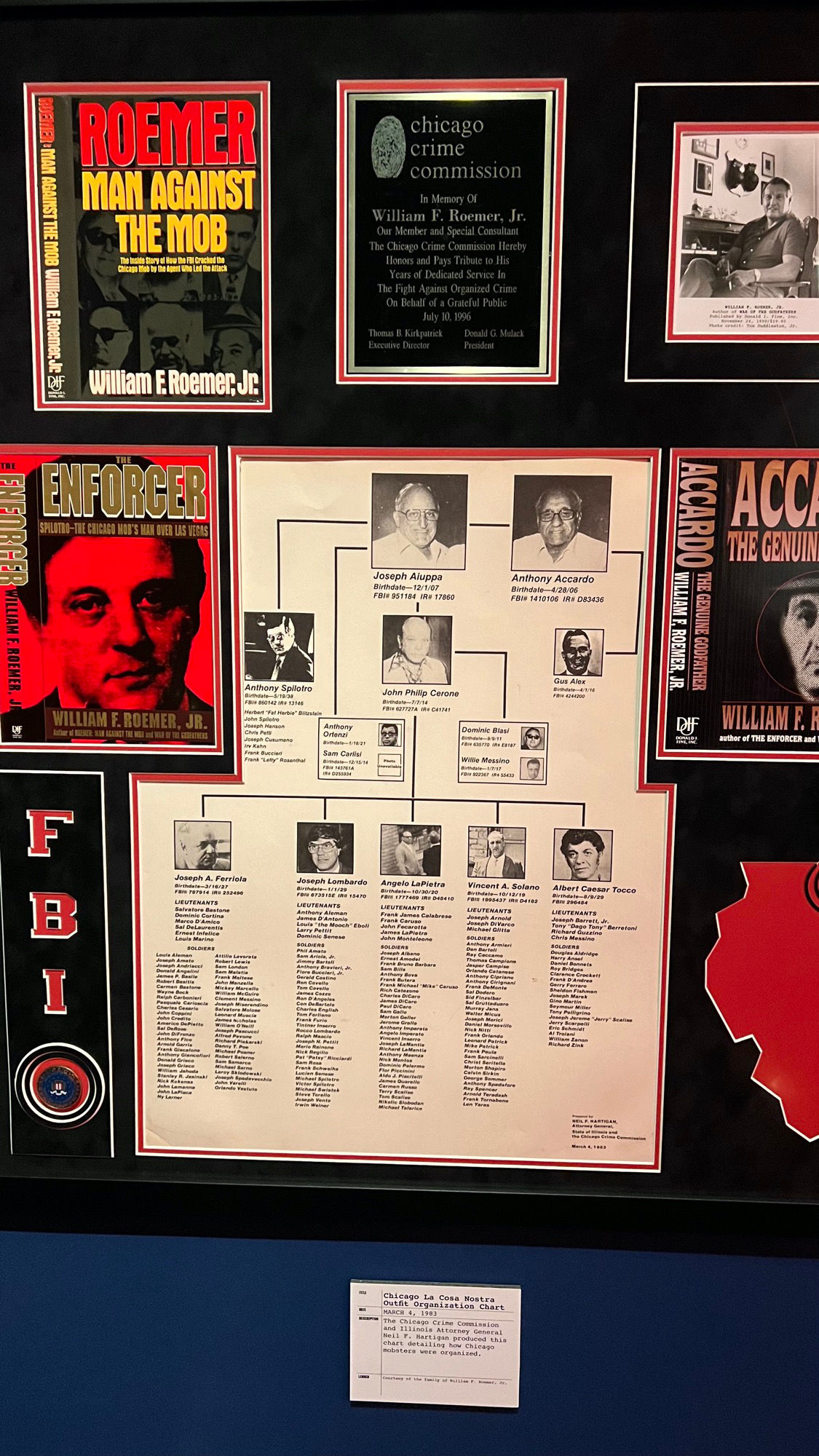
March 4, 1983
The Chicago Crime Commission and Illinois Attorney General Neil P. Hartigan produced this chart detailing how Chicago mobsters were organized.
- Joseph Aiuppa
- Anthony Spilotro
Herbert "Fal Herblo" Billzstein
John Spilotro
Joseph Hanson
Chris Petti
Joseph Cusumano
Irv Kahn
Frank Buccieri
Frank "Lelty" Rosenthal
- Anthony Ortenzi
- Sam Carlisi
- John Phillp Cerone
- Dominic Blasi
- Wille Messino
- Joseph A. Ferriola
LIEUTENANTS:
Salvatore Bastone
Dominio Cortina
Marco D'Amico
Sal DeLourentis
Ernest Infelice
Louis Marino
- Joseph Lombardo
LIEUTENANTS:
Anthony Aleman
Jamos D'Antonio
Louis "The Mooch" Eboli
Larry Pettit
Dominio Senese
- Angelo LaPietra
LIEUTENANTS:
Frank James Calabrese
Frank Caruso
John Fecarotta
James LaPietra
John Monteleone
- Vincent A. Solano
LIEUTENANTS:
Joseph Arnold
Joseph DiVarco
Michael Glitta
- Albert Caesar Tocco
LIEUTENANTS:
Joseph Barrett, Jr.
Tony "Dago Tony" Berrretoni
Richard Guzzino
Chris Messino
- Anthony Spilotro
- Anthony Accardo
- Gus Alex
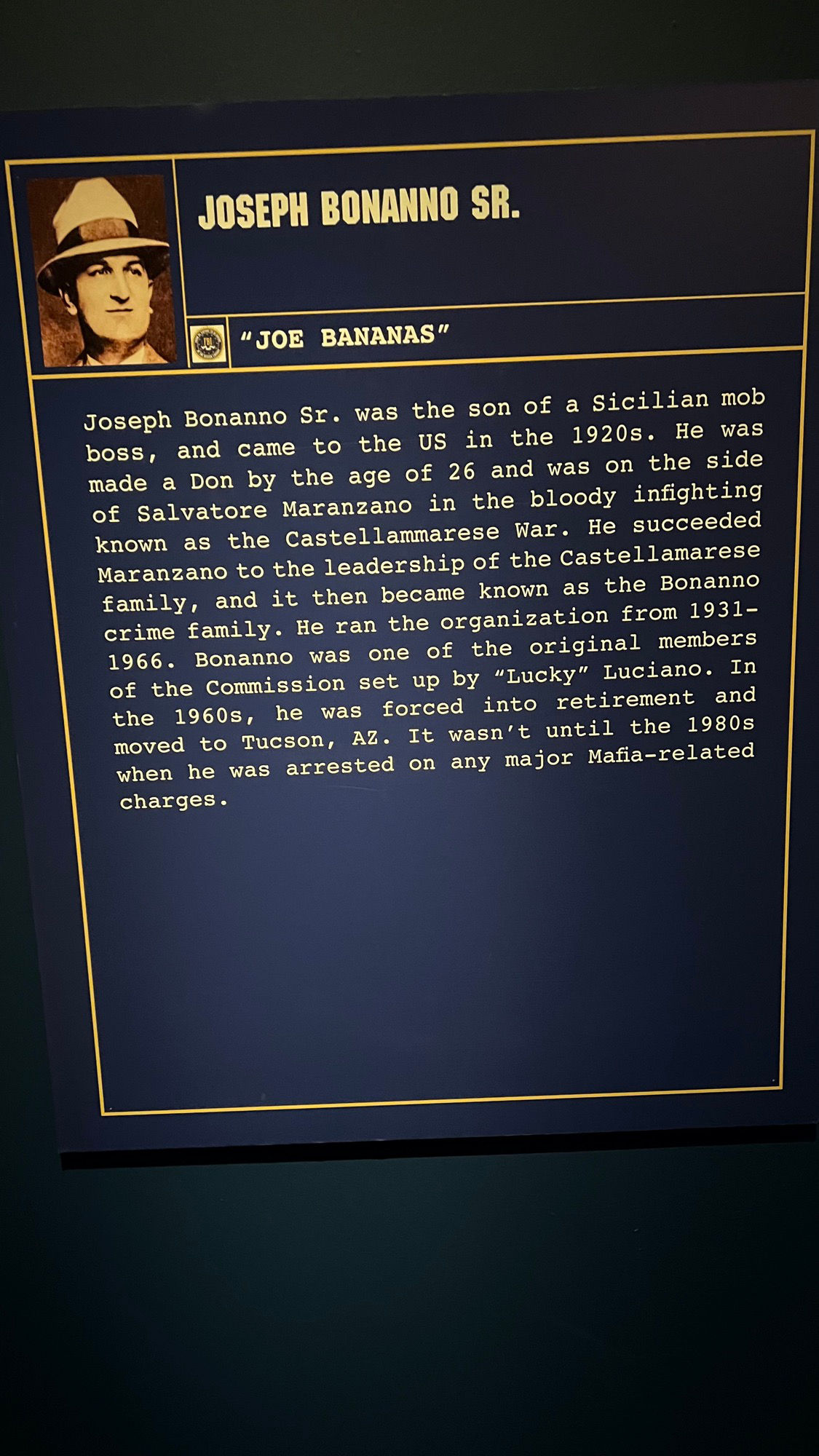
Joe Bananas
Joseph Bonanno Sr. was the son of a Sicilian mob boss, and came to the US in the 1920s. He was made a Don by the age of 26 and was on the side of Salvatore Maranzano in the bloody infighting known as the Castellammarese War. He succeeded Maranzano to the leadership of the Castellammarese family, and it then became known as the Bonanno crime family. He ran the organization from 1931-1966. Bonanno was one of the original members of the Commission set up by "Lucky" Luciano. In the 1960s, he was forced into retirement and moved to Tucson, AZ. It wasn't until the 1980s when he was arrested on any major Mafia-related charges.
[]
[https://vault.fbi.gov/joseph-bonanno]
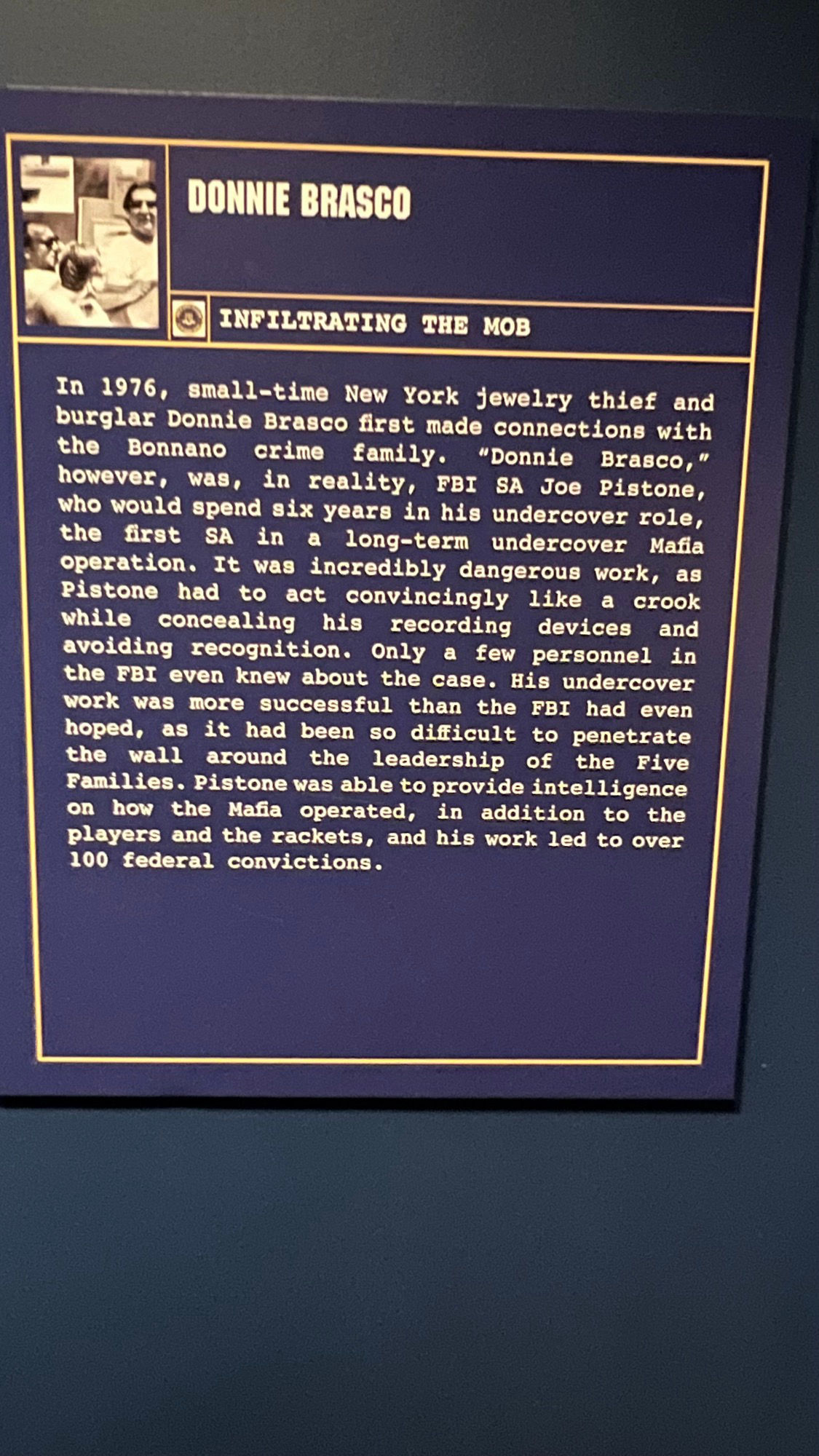
Infiltrating the Mob
In 1976, small-time New York jewelry thief and burglar Donnie Brasco first made connections with the Bonnano crime family. "Donnie Brasco," however, was, in reality, FBI Special Agent Joe Pistone, who would spend six years in his undercover role, the first Special Agent in a long-term undercover Mafia operation. It was incredibly dangerous work, as Pistone had to act convincingly like a crook while concealing his recording devices and avoiding recognition. Only a few personnel in the FBI even knew about the case. His undercover work was more successful than the FBI had even hoped, as it had been so difficult to penetrate the wall around the leadership of the Five Families. Pistone was able to provide intelligence on how the Mafia operated, in addition to the players and the rackets, and his work led to over 100 federal convictions.
FBI Donnie Brasco was an FBI Agent
Dominick "Sonny Black" Napolitano just couldn't believe it.On July 26, 1981, he and his fellow wise guys learned that Donnie Brasco-who they knew as a small-time jewelry thief and burglar, who they thought was their partner and even their friend, who they were about to officially induct into the Bonnano crime family-was actually FBI Agent Joe Pistone.
Pistone had fooled them all with a masterful acting job that had begun in 1976 and lasted six long years.
He had appeared in "Little Italy" in New York City as a stranger and outsider, slowly meeting and making friends with a series of mobsters, gaining their trust, making it look like he was participating in their life of crime-all the while secretly gathering vital intelligence on the Mafia and its criminal ways.
It wasn't easy, to be sure. Pistone had to think, talk, and act like a crook (he spent two full weeks, for example, studying the jewelry industry). He had to know the rules of the Mafia game. He had to tell lies-lots of lies-convincingly, about who he was and what he was up to. He had to make friends with mobsters and criminals and be separated from family and friends for long stretches of time, even on holidays.
It was incredibly dangerous work as well. While playing his part, Pistone could have been seen with the wrong person or been recognized by someone he knew. His various recording devices could have been exposed or gone haywire and given him away. He might have let a word slip. The slightest mistake or accident could have cost him his life. His mission was so secret that only a handful in the FBI knew about it.
The decision to put Pistone into this undercover role was made by the FBI's office in New York City, home of the five main Mafia families-Bonanno, Gambino, Colombo, Genovese, and Lucchese.
In years past, the Bureau had some success in gathering intelligence on the mob, but typically only around the edges. The core-the leadership-was often untouchable because of the Mafia's code of silence.
Agents in the FBI's New York office decided to try out a longer-term undercover operation-one of the first of its kind. But even they had no idea that it would end up lasting so long and bearing so much fruit.
And what an intelligence goldmine it was. The operation gave the FBI a window into the inner workings of the Mafia generally and the Bonanno family specifically (and to a lesser degree, some of the other families), not only in New York, but in Florida, Michigan, and elsewhere. The Bureau learned firsthand who the players were, what kinds of rackets they were running, and what rules they played by. And it ultimately led to more than 100 federal convictions.
The tool that Pistone and a small band of agents bravely pioneered in the ‘70s was used again and again with great effect over the next several decades, generating intelligence that helped the FBI and its partners target and take down major criminal enterprises and deal a serious blow to the Mafia. And it became a staple of the Bureau's intelligence tradecraft, a crucial arrow in the quiver used to protect the American people
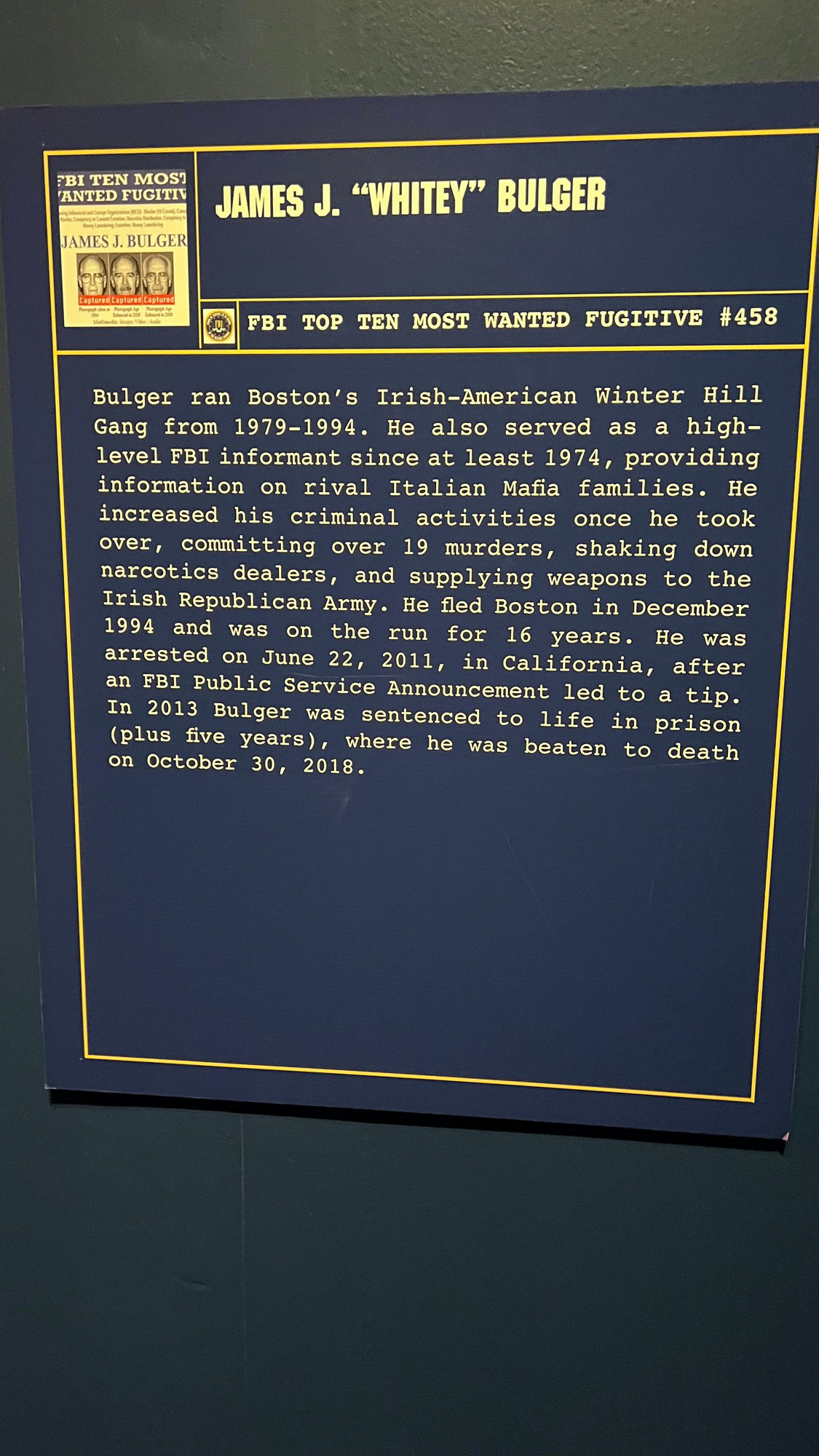
FBI Top Ten Most Wanted Fugitive #458
Bulger ran Boston's Irish-American Winter Hill Gang from 1979-1994. He also served as a high-level FBI informant since at least 1974, providing information on rival Italian Mafia families. He increased his criminal activities once he took over, committing over 19 murders, shaking down narcotics dealers, and supplying weapons to the Irish Republican Army. He fled Boston in December 1994 and was on the run the run for 16 years. He was arrested on June 22, 2011, in California, after an FBI Public Service Announcement led to a tip. In 2013 Bulger was sentenced to life in prison (plus five years), where he was beaten to death on October 30, 2018.
[]
[https://vault.fbi.gov/james-whitey-bulger]
WIKIPEDIA James Joseph "Whitey" Bulger Jr.
(September 3, 1929 – October 30, 2018)
Was an American organized crime boss who led the Winter Hill Gang in the Winter Hill neighborhood of Somerville, Massachusetts, a city directly northwest of Boston. On December 23, 1994, Bulger fled the Boston area and went into hiding after his former FBI handler, John Connolly, tipped him off about a pending RICO indictment against him. Bulger remained at large for sixteen years. After his 2011 arrest, federal prosecutors tried Bulger for nineteen murders based on grand jury testimony from Kevin Weeks and other former criminal associates.Although Bulger adamantly denied it, the FBI revealed that he had served as an informant for several years starting in 1975. Bulger provided information about the inner workings of the Patriarca crime family, his Italian-American Mafia rivals based in Boston and Providence, Rhode Island. In return, Connolly, as Bulger's FBI handler, ensured that the Winter Hill Gang were effectively ignored. Beginning in 1997, press reports exposed various instances of criminal misconduct by federal, state, and local officials with ties to Bulger, causing embarrassment to several government agencies, especially to the FBI.
Bulger became a fugitive in 1994 and was added to the FBI's Ten Most Wanted Fugitives list in 1999, and was considered the most wanted person on the list behind Osama bin Laden. He was apprehended along with his longtime girlfriend, Catherine Greig, outside an apartment complex in Santa Monica, California, on June 22, 2011. By then he was 81 years old. Bulger and Greig were then extradited to Boston and taken to court under heavy guard. In June 2012, Greig pleaded guilty to conspiracy to harbor a fugitive, identity fraud, and conspiracy to commit identity fraud, receiving a sentence of eight years in prison. Bulger declined to seek bail and remained in custody.
Bulger's trial began in June 2013. He was tried on thirty-two counts of racketeering, money laundering, extortion and weapons charges, including complicity in nineteen murders. On August 12, Bulger was found guilty on 31 counts, including both racketeering charges, and was found to have been involved in eleven murders. On November 14, he was sentenced to two consecutive life sentences plus five years by U.S. District Court Judge Denise J. Casper. Bulger was incarcerated at the United States Penitentiary Coleman II in Sumterville, Florida.
Bulger was transferred to several facilities in October 2018; first to the Federal Transfer Center in Oklahoma and then to the United States Penitentiary, Hazelton, near Bruceton Mills, West Virginia. Bulger, who was in a wheelchair, was beaten to death by inmates on October 30, 2018, within hours of his arrival at Hazelton. In 2022, Fotios Geas, Paul DeCologero and Sean McKinnon were charged with conspiracy to commit first-degree murder in Bulger's death.
